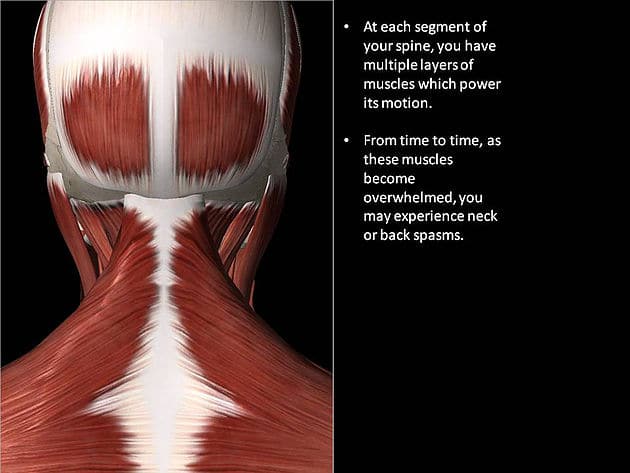Understanding Spine Anatomy
To understand what’s wrong with your spine, it helps to understand the basic anatomy. The bones of your spine provide structure and support for your body. They also serve as a protective tunnel for your spinal cord, which carries nerve signals from your brain down to the rest of your body. The spine is divided into 3 main regions and made up of bones called vertebrae. The 3 regions of the spine are the cervical spine, the thoracic spine, and the lumbar spine. As you can see, each region of the spine has a distinct curvature creating an overall S-shaped structure.
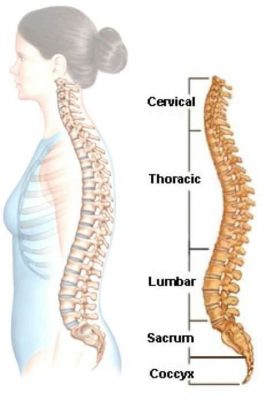
Cervical Spine (Neck)
The top portion of your spine, which is just below your skull, at the level of your neck, is known as the cervical spine. This region of the spine has 7 bones, also known as vertebrae. As seen in the figure, they’re labeled C1 through C7. The C stands for “cervical” while the numbers indicate the level. The bones are labeled 1 through 7 while the disks in between the bones are labeled for the 2 vertebrae they are between. For instance, the C5-6 disc is between the 5th and 6th cervical vertebrae.
The cervical spine has a backward “C”-shape-just like the lumbar spine. This type of curve is called a lordotic curve. The cervical spine is much more mobile than both of the other segments of the spine.
The two upper vertebrae of the cervical spine are called the atlas and the axis, also known as C1 and C2. They differ from the other vertebrae because they are designed specifically for rotation. These two vertebrae are the reason your neck and head can move in so many directions.
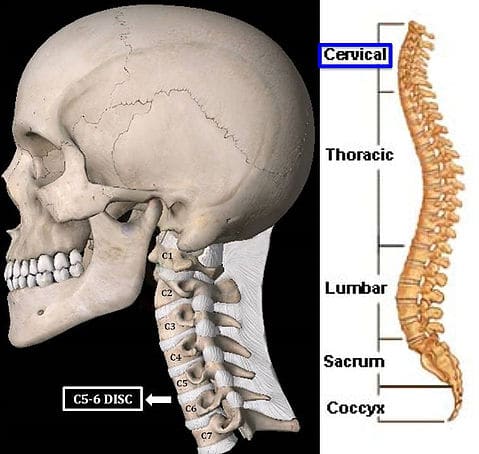
Thoracic Spine (Upper Back)
The thoracic spine is the mid-portion of your spine and is made up of 12 vertebrae. It is located below the top 7 vertebrae of the cervical spine and above the lumbar spine. These vertebrae connect to your ribs. The curve of the thoracic spine is a “C”-shape with the opening of the “C” in the front. This type of curve is called a kyphotic curve.
The bones of the thoracic spine are labeled T1 through T12, with the T standing for “thoracic.” Similar to other portions of the spine, it is the bones which are numbered. The disc is numbered according to the two bones it is between. For instance, the T10-11 disc is between the T10 and T11 vertebrae.
The thoracic spine has small intervertebral discs which in combination with its attachment to your ribs, limits the amount of movement as compared to your cervical or lumbar spine.
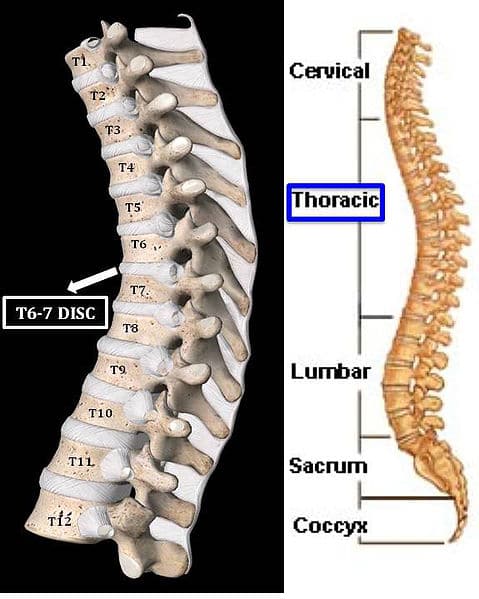
The Lumbar Spine (Low Back)
The area of the spine around your low back is called the lumbar spine. This area usually has 5 vertebrae. The lumbar spine connects to the sacrum, which acts as the foundation of your spine. The sacrum then, in turn, connects to your pelvis, which connects to your legs.
The bones of the lumbar spine are number L1 through L5, with the L standing for “lumbar.” Again, the discs are numbered for the two bones they are in between. For instance, the L4-5 disc is between the L4 and L5 vertebrae. Of special note in the lumber spine, the L5-S1 disc is in between the L5 vertebral body and the first bone of the sacrum (called S1).
The lumbar spine is shaped just like the cervical spine, with a lordotic curve. The vertebrae in the lumbar spine are the largest of the entire spine. The lumbar spinal canal is also larger than in the cervical or thoracic segments of the spine. The size of the lumbar spine allows for more space for nerves to move about.
When people experience pain in their spine it often occurs in the lumbar region. This is because the lumbar spine is connected to your pelvis, which is where most weight bearing and body movement takes place. Typically this is where people tend to place too much pressure, such as when lifting up a heavy box, twisting to move a heavy load, or carrying a heavy object. These activities can cause repetitive injuries that can lead to damage to the parts of the lumbar spine.
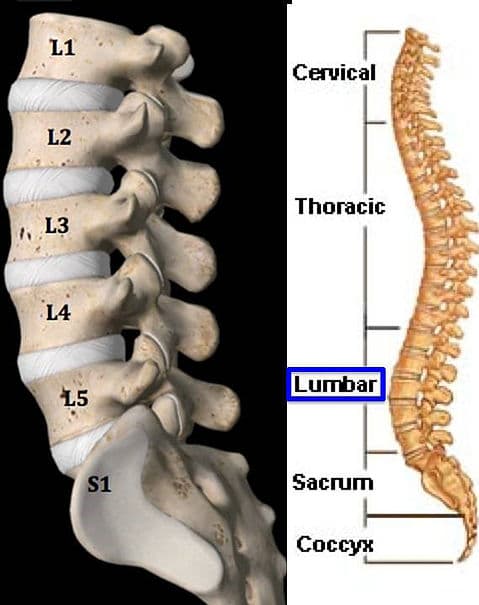
Vertebrae
Your spine is made up of small bones, called vertebrae. The vertebrae protect and support the spinal cord. They also bear the majority of the weight put upon your spine. Vertebrae, like all bones, have an outer shell, called cortical bone, which is hard and strong. The inside is made of a soft, spongy type of bone, called cancellous bone.
Each vertebrae has a bony ring on its back side. When the vertebrae are stacked one on top of the other, the rings create a hollow tube for the spinal cord to pass through. Each vertebra is held to the others by groups of ligaments and the disc in between vertebrae.
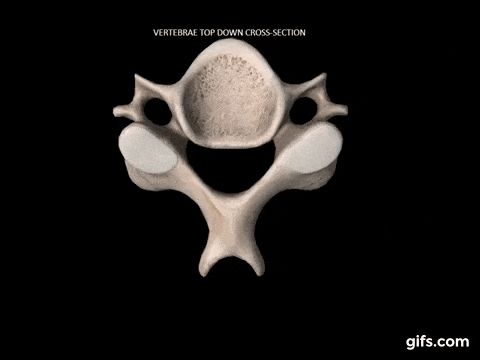
The Intervertebral Disc
Between each vertebra is a soft, gel-like cushion, called an intervertebral disc. These flat, round “cushions” act like shock absorbers by helping absorb pressure put on the spine. The discs prevent the bones from rubbing against each other.
Each disc has a strong outer ring of fibers called the annulus, and a soft, jelly-like center called the nucleus pulposus. The annulus is the strongest area of the disc. It helps keep the disc’s center intact.
The mushy nucleus of the disc serves as the main shock absorber. The nucleus is made up of tissue that is very moist because it has high water content. The water content is what helps the disc act like a shock absorber-somewhat like a waterbed mattress.
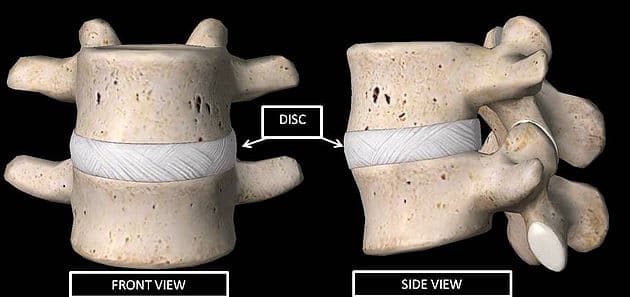
Facet Joints
Similar to hips and knees, the spine has its own set of joints, called facet joints. The facet joints link the vertebrae together and give them the flexibility to move against each other. There are two facet joints between each pair of vertebrae, one on the left and one on the right side.
The facet joints allow movement between two bones. The ends of the bones are covered with cartilage that allows the bones to glide against one another without much friction. Fluid inside the joint keeps the joint surfaces lubricated. This fluid is contained inside the joint by the joint capsule, a watertight pouch that fully surrounds and encloses the joint.
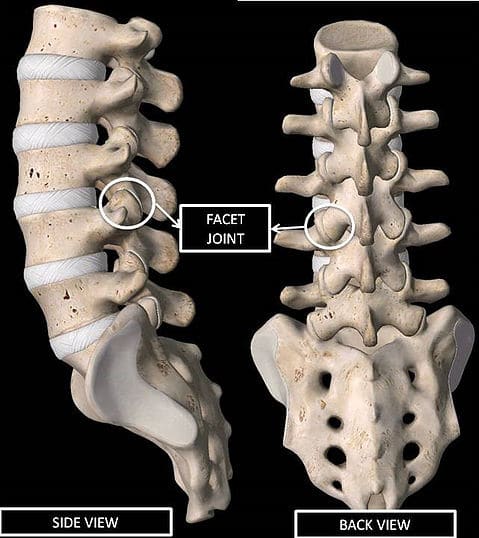
Neural Foramen
At each level of the spinal cord, a pair of nerve roots branches off and exits the spine through small openings on each side of the vertebra called the neural foramen. The two nerve roots in each pair go in opposite directions with one going to the left side of your body and the other to your right side. The nerve roots allows signals to travel to and from your brain to the rest of your body.
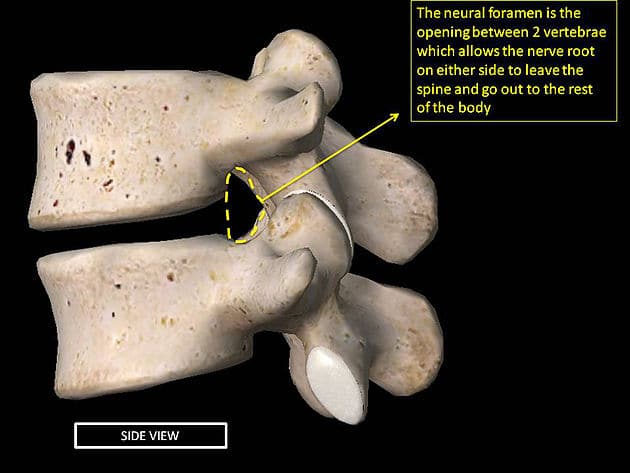
Spinal Cord
The spinal cord is a column of millions of nerve fibers that carries messages from your brain to the rest of your body. It extends from the brain to the area between the end of the first and second lumbar vertebrae. The spinal cord lies within the hollow canal called the spinal canal that is formed when the spinal vertebrae stack on top of each other (see Figure 5). The spinal canal holds and protects the entire spinal cord and its nerve roots.
The spinal cord only goes down to the second lumbar vertebra. Below this level, the spinal canal contains a group of nerve fibers, called the cauda equina. This group of nerves goes to the pelvis and lower limbs.
A protective membrane, called the dura mater covers the spinal cord. The dura mater forms a watertight sac around the spinal cord and the spinal nerves. Inside this sac, the spinal cord is surrounded by spinal fluid, which also protects the spinal cord.
Nerve Roots
The nerve fibers in your spinal cord branch off to form pairs of nerve roots that travel through the small openings between your vertebrae (see Figure 8). The nerves in each area of the spinal cord connect to specific parts of your body. This is why damage to the spinal cord can cause paralysis in certain areas and not others. It depends on which spinal nerves are affected.
The nerves of the cervical spine go to the upper chest and arms. The nerves of the thoracic spine go to the chest and abdomen. The nerves of the lumbar spine go to the legs, pelvis, bowel, and bladder. These nerves coordinate and control all your body’s organs and parts, and allow you to control your muscles.
The nerve roots carry electrical signals back to the brain that allow you to feel sensations. If your body is being hurt in some way, your nerves signal the brain. Damage to the nerves themselves can cause pain, tingling, or numbness in the area where the nerve travels. Without nerve signals, your body would not be able to function.
Back Muscles
The muscles next to the spine are called the paraspinal muscles. They support the spine and motors to move the spine. Joints allow flexibility, and muscles allow mobility. There are many small muscles in your back. Each controls some part of the total movement between the vertebrae and the rest of the skeleton. These muscles can be directly injured, such as when you have a pulled muscle or muscle strain. They can also cause problems indirectly, such as when they are in spasm after injury to other parts of the spine.
A muscle spasm is experienced when your muscle tightens up and will not relax. Spasms usually occur as a reflex (meaning that you cannot control the contraction). When any part of the spine is injured-including a disc, ligament, bone, or muscle-the muscles automatically go into spasm to reduce the motion around the area. This mechanism is designed to protect the injured area.
